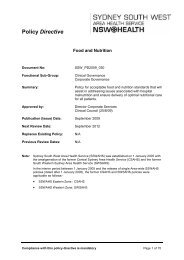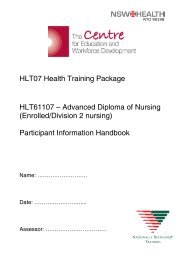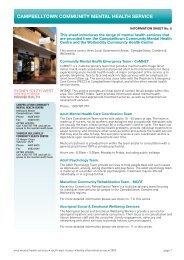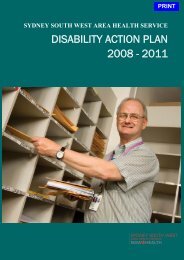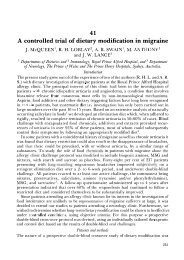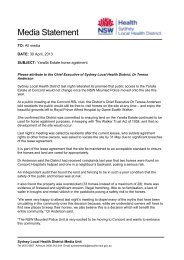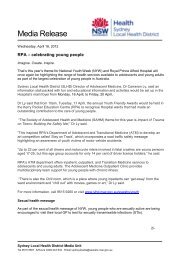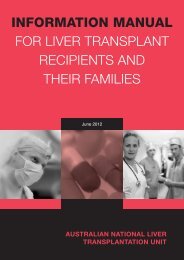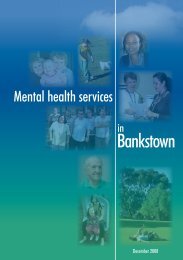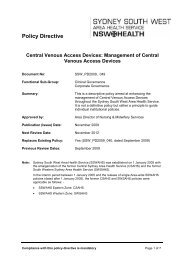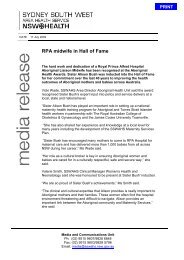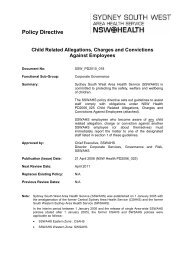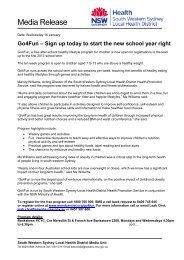Aged Care & Rehabilitation Clinical Services Plan 2007 – 2012
Aged Care & Rehabilitation Clinical Services Plan 2007 – 2012
Aged Care & Rehabilitation Clinical Services Plan 2007 – 2012
You also want an ePaper? Increase the reach of your titles
YUMPU automatically turns print PDFs into web optimized ePapers that Google loves.
<strong>Aged</strong> <strong>Care</strong> & <strong>Rehabilitation</strong> <strong>Clinical</strong> Service <strong>Plan</strong> <strong>2007</strong> - <strong>2012</strong>Recommendation – Mental HealthEstablish collaborative processes to improve the coordination and integration of <strong>Aged</strong> <strong>Care</strong>and Specialist Mental Health <strong>Services</strong> for Older People, particularly in the management ofpeople with behavioural and psychological symptoms of dementia8.3 Other Subspecialty Medicine and SurgeryGiven the projected increase in the number of older patients over the next 5 - 10 years, there will bea need to ensure that all inpatient services, not just designated aged care services, are able to betterrespond to the needs of this group of patients. This is consistent with the Framework for theIntegrated Support and Management of Older People in the NSW Health <strong>Care</strong> System.To do this requires improvements to the way in which general medical and surgical wards respond tothe needs of, in particular, the aged care client. Different solutions may be required in differentfacilities, depending on the availability of other sub-specialty services.Strategies to achieve this include developing and/or formalising admission protocols, developingshared care models, improving access to aged care expertise and support, and improving earlyidentification and prevention of aged care specific complications. These issues have beenconsidered through the Older Persons and <strong>Aged</strong> <strong>Care</strong> <strong>Clinical</strong> Redesign Project and variouspotential solutions have been documented (refer to SSWAHS Older People and <strong>Aged</strong> <strong>Care</strong> HealthService Project Solution Design Report, February <strong>2007</strong>).Further, models of Ambulatory <strong>Care</strong> and Community Acute/Post Acute <strong>Care</strong> (CAPACs) provideopportunities for other subspecialties to take an active role in the care of the aged care client. Thisis formalised to varying degrees depending on the facility. The availability of these servicesfacilitates early medical intervention in a non-inpatient setting (hospital outpatient or community) andenables discharge of patients with ongoing medical and nursing support services. People with achronic disease are significant users of these services. The availability of Ambulatory <strong>Care</strong>/CAPACsreduces the need for hospital admissions for chronic diseases.Recommendation – Other Subspecialty Medicine and SurgeryImplement a range of initiatives to improve the responsiveness of SSWAHS to the needs ofolder people, people with a disability and their carers8.4 Allied HealthAllied Health <strong>Services</strong>, provided as part of a multi-disciplinary team, are integral to the provision ofhigh quality aged care and rehabilitation services. Allied health staff include physiotherapists,occupational therapists, speech pathologists, podiatrists, social workers,psychologists/neuropsychologists and dietitians/nutritionists. The administrative models ofmanagement vary across SSWAHS. In the east of the Area, community based allied health staffworking in aged care and rehabilitation are part of GGRM, whilst inpatient staff are managed throughthe hospital allied health departments in close association with GGRM. In the south west, twodifferent models of allied health management are operating. This is the subject of discussionbetween the relevant clinical groupings.There is a workforce shortage across all Allied Health disciplines, leading to difficulties in meetingthe demand for a range of services. Across SSWAHS, particularly in lower socioeconomic localities,there are also few private allied health providers to support public services.Allied Health <strong>Services</strong> provide a variety of hospital and community based programs to support andcomplement AC&RS and other health services. The key programs run by Allied Health whichservice AC&R clients are summarized below.8.4.1 Equipment Lending PoolsSSWAHS Allied Health manage the Equipment Lending Pools (ELPs). ELPs lend equipment topatients for a defined period to support their discharge from hospital. They need to be expanded toPage 63




